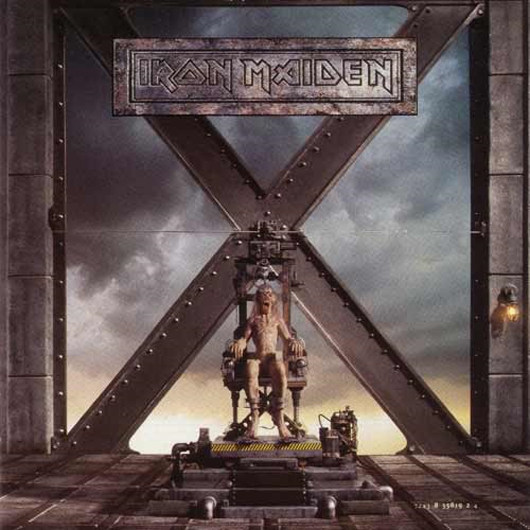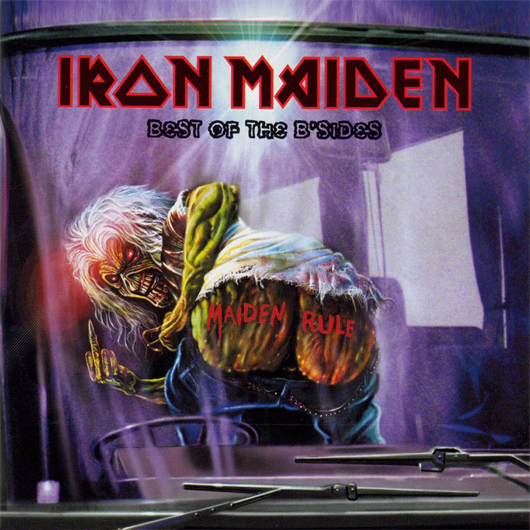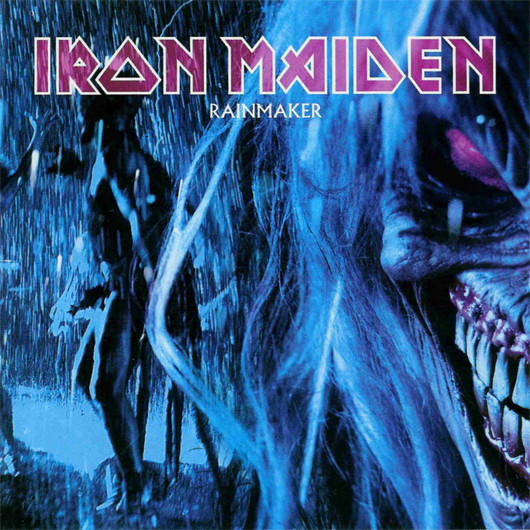Iron Maiden: a gruesome history of graphic artwork
Eddie The Head, Derek Riggs, hidden messages and The Final Frontier
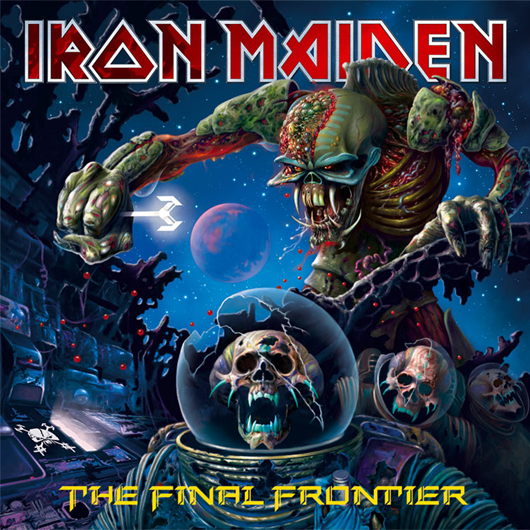
Iron Maiden: a gruesome history of graphic artwork
Heavy metal’s identity is rooted almost as deeply in its imagery as the music itself, and British pioneers Iron Maiden were (and some band members still are) proud exponents of the long hair, ripped-denim, spandex and leather uniform of the '80s. Maiden’s image, however, is all the more enduring - and somewhat remarkably for a heavy metal band, endearing - thanks to the most famous band mascot of all time, Eddie The Head.
Originally designed by Derek Riggs, adopted by the band, and brought to life as a blood-drooling mask at the back of the stage; Eddie’s been a perennial, zombie-like fixture at almost every gig, and on almost every Maiden release since 1980’s debut single, Running Free.
As you’ll see from the following celebration of Iron Maiden’s gloriously gruesome, benchmark-setting artwork, Eddie has evolved along with the band and their musical direction. From lobotomised street-prowling urchin to Satan-battling, time-travelling cyborg - Ed’s 30-year coming of age has been a painful yet compelling journey.
So, on the eve of Maiden’s 15th studio album release The Final Frontier, join us as we relive the band’s impressively graphic back catalogue. All the quotes from Derek Riggs come courtesy of his excellent online portfolio (a veritable hive of insights from the designer himself), while massive props must go to top fan sites Maiden World and Iron Maiden Wallpaper for sharing all the hidden messages and hi-res artwork you could wish for. Go visit them now.
STOP PRESS (i): Check out our exhaustive track-by-track review of Iron Maiden's new album, The Final Frontier. It's a genuine shocker.
STOP PRESS (ii): Eddie shredders should check out the latest issue of Metal Hammer with its brilliant 3D cover for the release of The Final Frontier. Check out an exclusive preview here.
First up: a shadow-obscured Eddie makes his debut
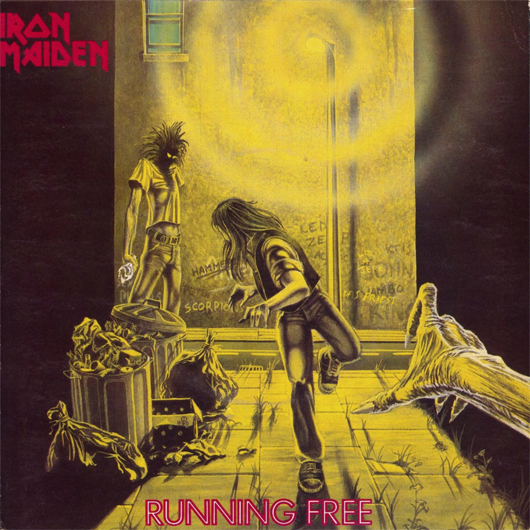
Running Free
Maiden’s first single, and the first official glimpse of Eddie The Head - albeit with a shadow-obscured face (they didn’t want to blow their mascot unveiling load until the album release).
Also note the graffiti on the back wall - a nod to influences Led Zeppelin, Judas Priest, AC/DC and Scorpions - and the word ‘Hammers’ in honour of the band’s beloved West Ham United Football Club.
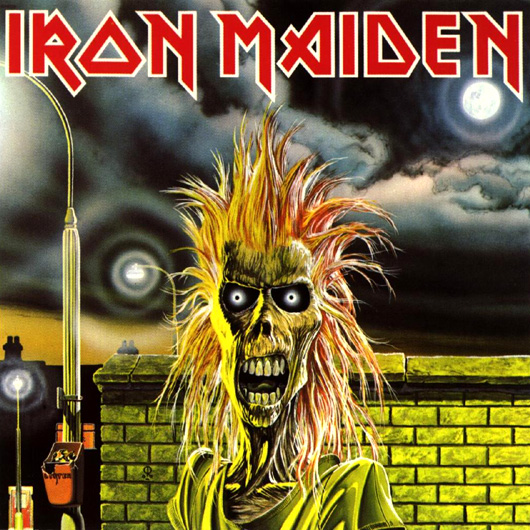
Iron Maiden
Hello, Eddie!
Here’s Derek Riggs on completing the first album cover: “When I finished this I sat back and thought ‘that is going to make me rich and famous’ - so I didn't get rich but I got moderately famous, so one half out of two ain't bad I suppose."
Live performances of self-titled album track, Iron Maiden, still often mark the entrance of the band’s mascot onstage.
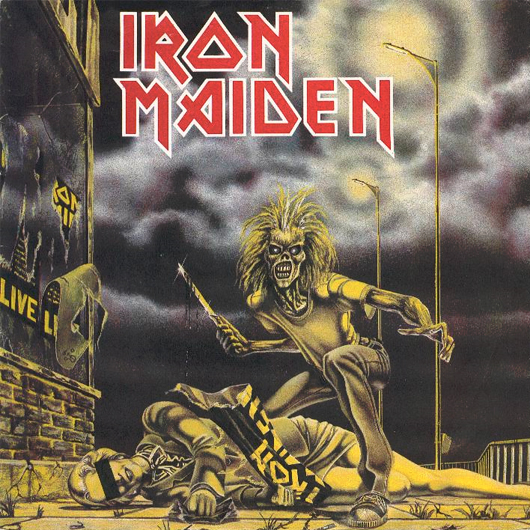
Sanctuary
By the band’s request, here’s Eddie stabbing an image of the Prime Minister of the time and the original ‘Iron Lady’, Margaret Thatcher. Early copies of the infamous single don’t feature the eye-covering black box.
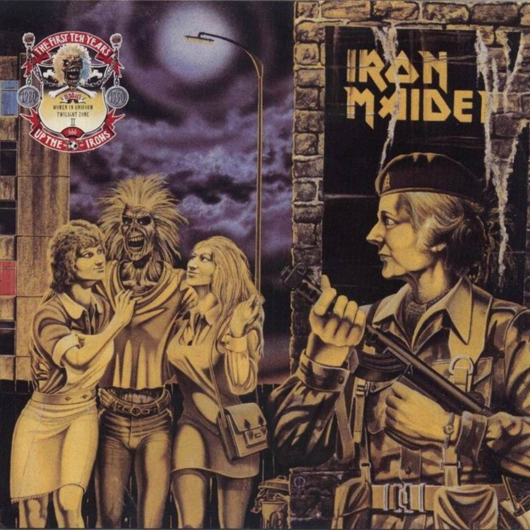
Women In Uniform
Pay-back time for the Iron Lady!
Here Riggs draws Thatcher waiting for Eddie holding a submachine gun. If that wasn’t controversial enough, Ed's somehow managed to pull a nurse and a school girl. Nice.
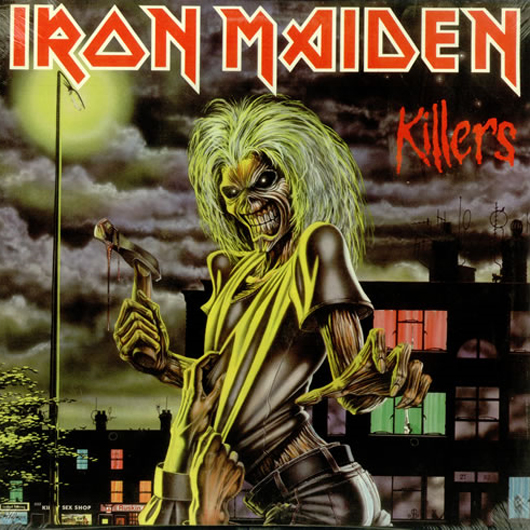
Killers
The block of flats in the background is based on Riggs’ UK home at the time: Etchingham Court, Etchingham Park Road, Finchley, North London, N4.
The flat are still there, although the artist isn't - Riggs now resides in California.
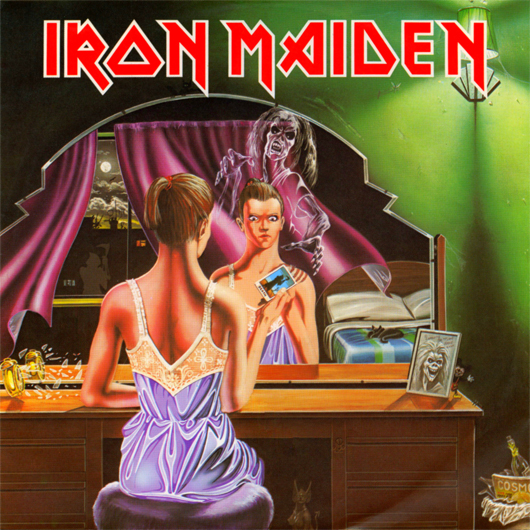
Twilight Zone
The picture of Eddie on top of the dresser says “To Charlotte…” - a reference to the character from Maiden’s debut album and the woman sitting above, Charlotte The Harlot.
Charlotte later appears on the Somewhere In Time cover, and the tracks 22 Acacia Avenue, Hooks In You (although not mentioned by name) and From Here To Eternity.
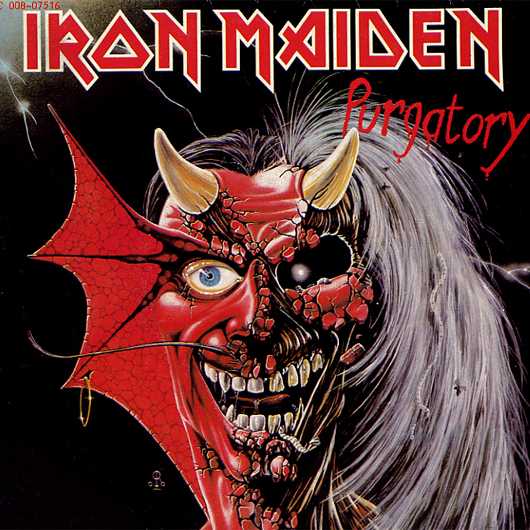
Purgatory
Riggs’ original artwork for Purgatory was deemed too complex for a single and it later surfaced as the cover of The Number Of The Beast album.
This second attempt features the artist’s first in a series of three devil-themed single covers. According to Riggs, the devil’s “golden earring is biker code for some kind of sexual activity.” Strewth.
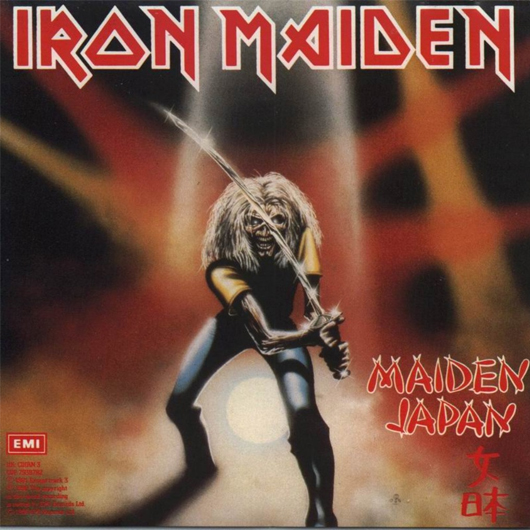
Maiden Japan
Unaware of band politics at the time, Riggs’ first attempt at this live EP’s cover (a play on Deep Purple’s Made In Japan) featured a soon-to-be-replaced Paul DiAnno. Erm…
After burning 250,000 copies, Maiden management commissioned this replacement at short notice.
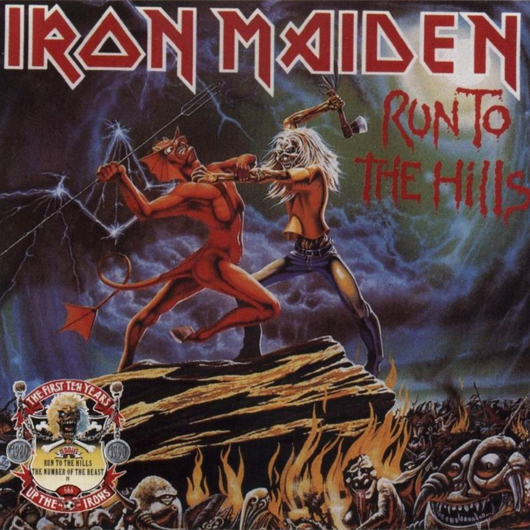
Run To The Hills
Back to the devil-themed trio! Riggs had already designed the battle scene before a record was assigned to it.
Note: As Run To The Hills is “a single about cowboys and Indians that Bruce wrote”, Eddie was given a tomahawk.
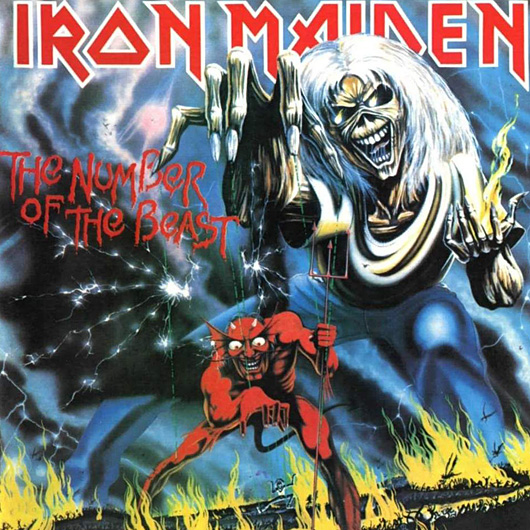
The Number Of The Beast
Despite the fact that most of Maiden's songs were inspired by literature and film, at this point the band were being accused of Satanism - the accompanying Beast On The Road Tour was particularly blighted by protesters in the US.
This depiction of Eddie controlling the devil with puppet strings probably didn’t help change opinion - although if you look closely, you can see that the devil is actually controlling a smaller version of Eddie.
According to Riggs it took “two days and nights without sleep” to complete.
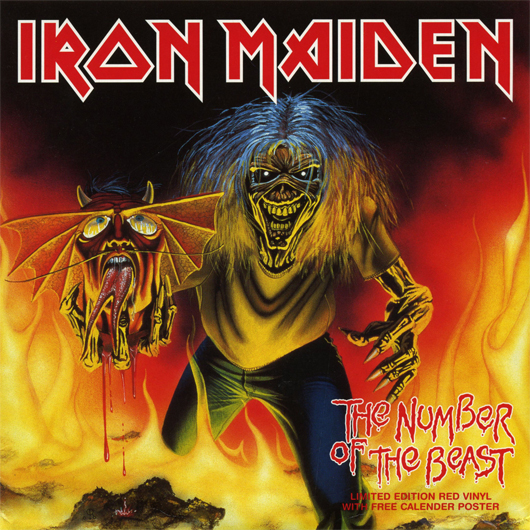
The Number Of The Beast
Riggs’ final devil portrayal in the series - Eddie is victorious. Apparently the devil was supposed to look like Salvador Dali but Riggs “couldn’t get any good pictures [to copy] in time.”
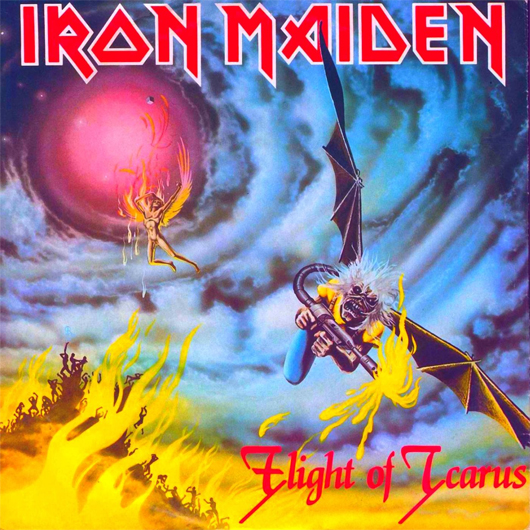
Flight Of Icarus
The song Flight Of Icarus is loosely based on the ancient Greek myth - Icarus flies too close to the sun, melts his wax-bound wings and falls to his death.
The artwork is a more humourous affair which shows Eddie killing Icarus with a flamethrower. Riggs’ depiction of a dying Icarus resembles William Rimmer’s Evening: Fall Of Day - the same figure adopted by Led Zeppelin who disbanded three years earlier.
The little cube in the distance above Icarus is Eddie’s cell from the next sleeve…
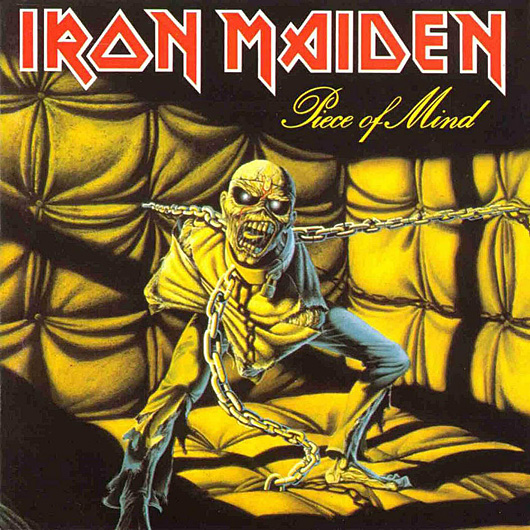
Piece Of Mind
Included in the liner notes to Maiden’s fourth album is a slightly altered passage from the Book Of Revelation (chapter 4, verse 21): “And God shall wipe away all tears from their eyes; and there shall be no more Death. Neither sorrow, nor crying. Neither shall there be any more brain; for the former things are passed away." The actual text reads: "neither shall there be any more pain."
The change is probably a reference to the album’s name and to further annoy the ‘Satanic’ accusers. Plus Eddie’s been lobotomised on the cover - the bolt in his head would (mostly) remain in Maiden artwork from this point onwards.
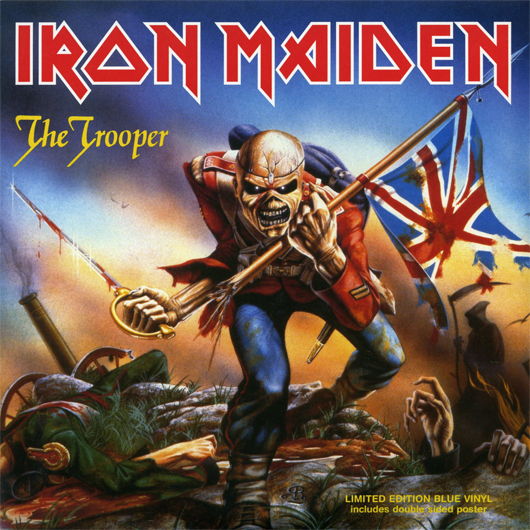
The Trooper
The Trooper is a song about the Battle Of Balaclava in 1854 - hence this depiction of Eddie stalking the trenches with cutlass and Union Jack.
“I think this is popular because it has a lot of red and blue in it,” writes Riggs. “The other covers don't have much red. I resist using red just for the sake of it (can you put more blood in it Derek... whinge... whinge).”
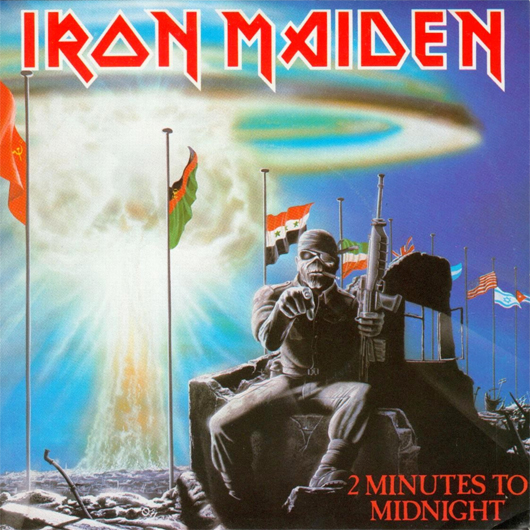
2 Minutes To Midnight
2 Minutes To Midnight is a song about the Doomsday Clock and the closest that clock has ever been to midnight (an atomic war - Doomsday) when the US and Soviet Union tested H-bombs within nine months of each other.
Meanwhile on the sleeve, nuclear fallout is obviously not an issue for Eddie, who has a front row seat…
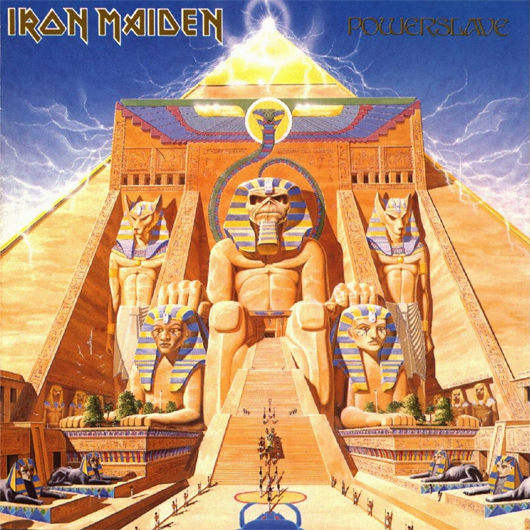
Powerslave
Instantly recognisable because of its ancient Egyptian-theme, the legendary Powerslave cover features Eddie as the shrine, and hidden messages ‘Bollokz’ and ‘What a load of crap’ on the left and right hand side of the pyramid respectively.
Trivia time: There’s also a Mickey Mouse hieroglyph in the bottom left corner…
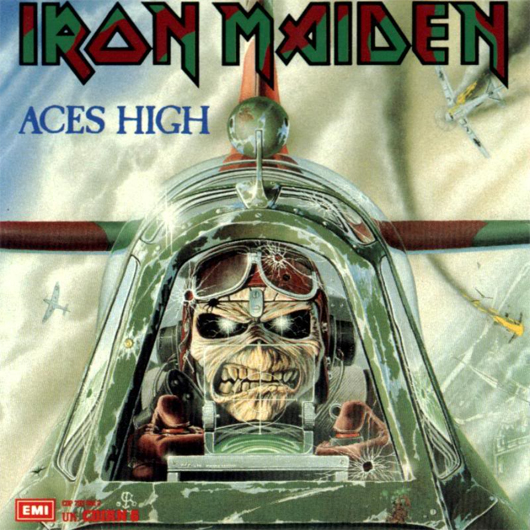
Aces High
A song about a British RAF pilot during the Battle Of Britain (1940) - the first battle fought entirely in the air.
Eddie effortlessly takes to the cockpit to fight the German Luftwaffe for the artwork, the idea for which Riggs borrowed "from a comic cover - Sgt. Rock I think - sometime in the 1960s."
A live version of Running Free was Maiden’s next single release on 13 September. However, the artwork is a photo of the band performing onstage, not a graphic image so it won't be appearing in our gruesome graphic gallery!
Oh, okay. Completists can download it here.
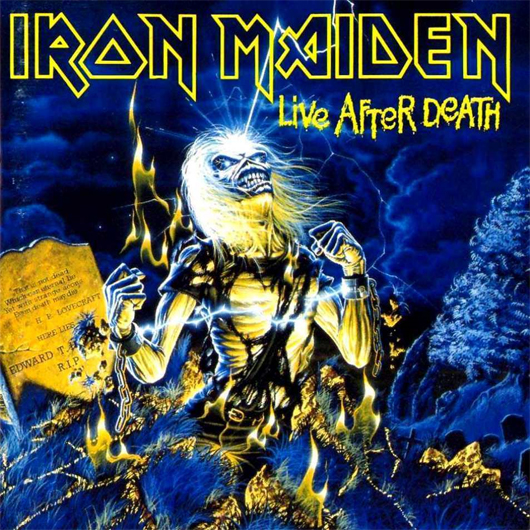
Live After Death
Eddie returns to his pre-Number Of The Beast long-haired days for this live album cover.
The gravestone he is rising from reads “Edward T H-“ with the remainder of his full name obscured. Another grave nearby reads “Here lies Derek Riggs.”
Look closely and you’ll see some mushrooms at the bottom right. Over to derek… “They were growing all over London at the time because some hippies had seeded all the public parks with magic mushroom spores.”
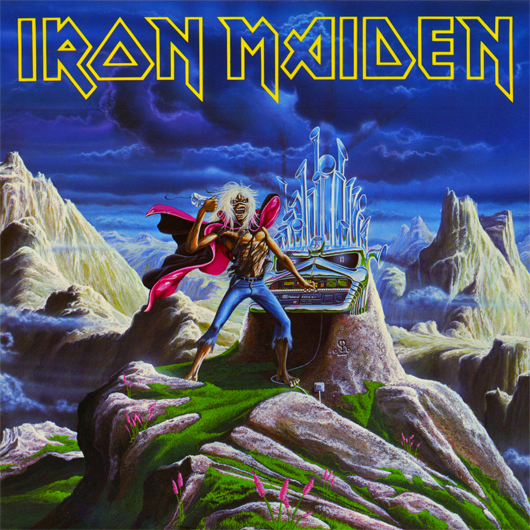
Run To The Hills (Live)
The second version of 1982’s Run To The Hills (with a live version of Phantom Of The Opera on the b-side, fact fans) and the first of two live cuts of the song to be released as a single.
Eddie’s playing an organ on a hill top pulling his mask off to reveal that he’s not actually the Phantom Of The Opera - surprise!
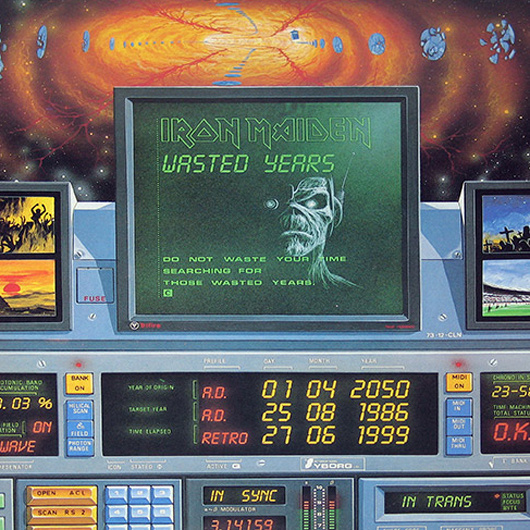
Wasted Years
Kicking off Riggs’ science fiction-themed artwork surrounding each Somewhere In Time release, the Wasted Years cover shows a spaceship-flying Eddie’s point of view as he chases Doctor Who’s Tardis.
Riggs wasn’t particularly proud of his work.
"The title Wasted Years turns anything into a negative, for example, if you put five guys playing guitars on the front it looks like they have been wasting their time… see what I mean?
"So basically we were fucked! This was the best and only idea I could come up with that would even remotely work within the constraints that we had to work with.”
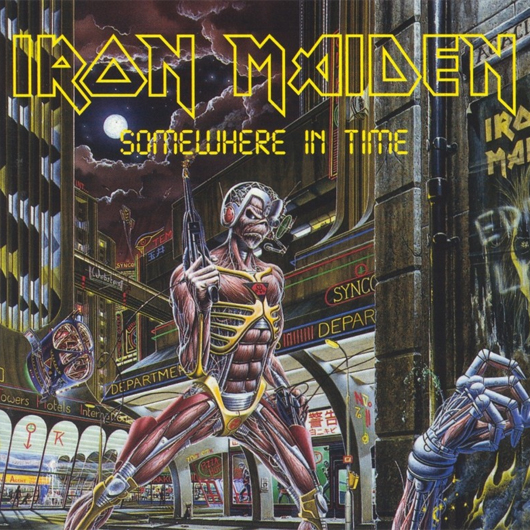
Somewhere In Time
This iconic Terminator/Blade Runner-esque cover - hello The Final Frontier - is full of hidden messages and references to past Maiden songs and band-related people and places.
Props then to the mighty Maiden World for pointing them all out: there’s a Tardis; West Ham are beating Arsenal 7-3 (unlikely); the clock reads 23:58 (2 Minutes To Midnight); and there’s the Ruskin Arms, The Rainbow Bar and Marquee Club (old haunts from earlier band days), to name but a few.
There’s also a backwards message behind Eddie’s right leg that reads: “This is a very boring painting.”
Clearly, Mr Riggs, it isn’t.
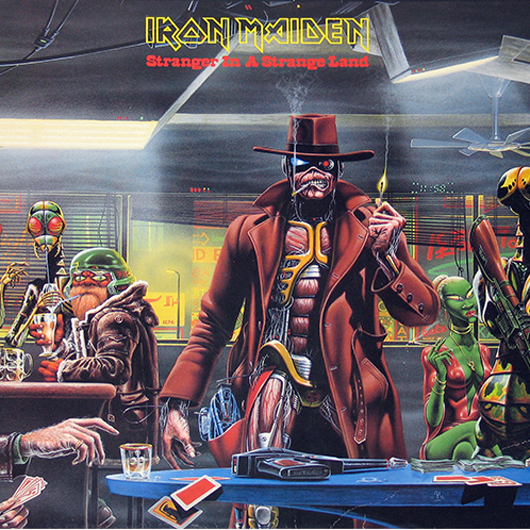
Stranger In A Strange Land
Looks like Eddie’s just wandered into the Mos Eisley cantina for a Clint Eastwood fancy dress party…
A fitting setting for Maiden’s second and final single from Somewhere In Time, then. According to Riggs: “the hairy guy on the left is someone I used to know. His name was Ron.”
Hello Ron.
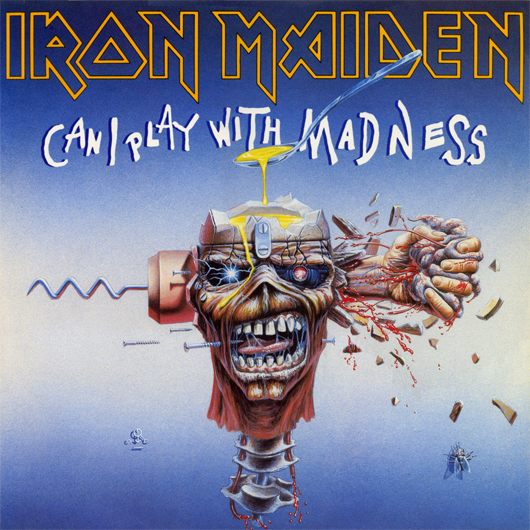
Can I Play With Madness
The first single from Seventh Son Of A Seventh Son sees a return to just Eddie The Head because Riggs was “getting a bit sick of painting him” and “was thinking of quitting from Maiden because they were getting increasingly difficult to work with.”
“I cut Eddie up into bits so I would have less to paint,” he writes.
Ulp.
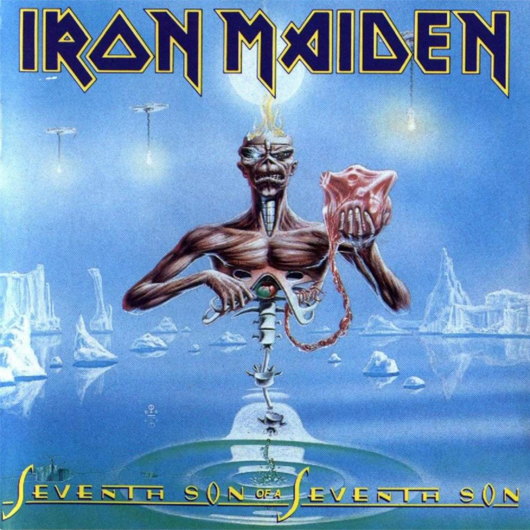
Seventh Son Of A Seventh Son
Torso, spilled entrails, a flaming head and an ice lake…
Maiden’s seventh studio effort was a concept album exploring ‘mysticism, prophetic vision, reincarnation and the afterlife’. According to Riggs, the cover features lots of “meaningful-looking nonsense.”
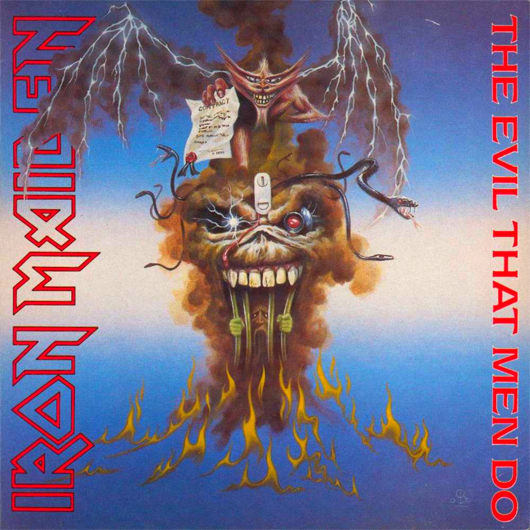
The Evil That Men Do
The metal plate in Eddie’s head features prominently here following his lobotomy on the Piece Of Mind cover.
According to Riggs: “It was completed in one single night - it’s not bad for one night’s work."
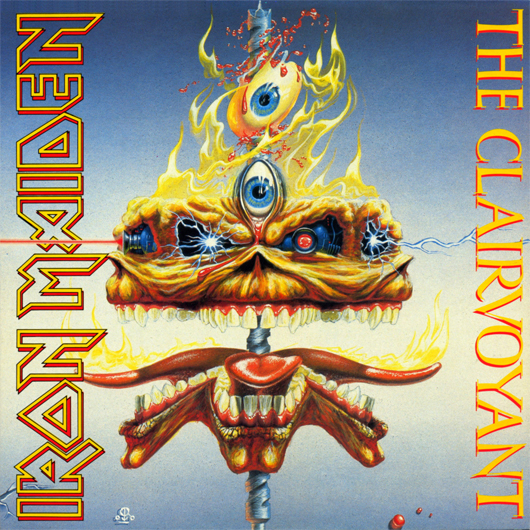
The Clairvoyant
A song inspired by the death of psychic Doris Stokes (yes, really) - hence Eddie’s ‘third (or inner) eye’.
Ed’s three faces represent the past, present and future. Riggs remains convinced that Queen borrowed the idea for their album The Miracle.
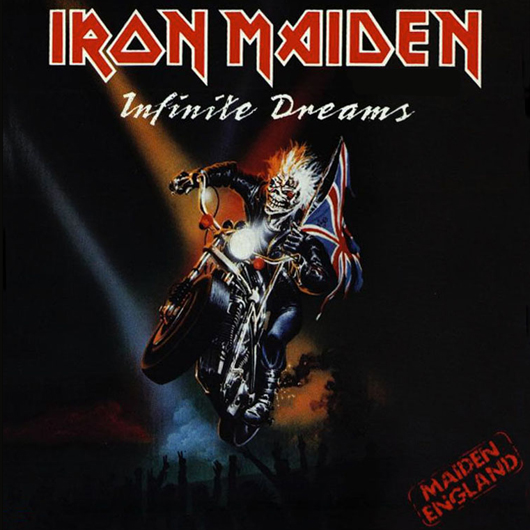
Infinite Dreams
This is a live version of a Seventh Son track released almost a year after The Clairvoyant - hence the design change.
Riggs says: “I hate painting motorbikes, they're fussy and boring.”
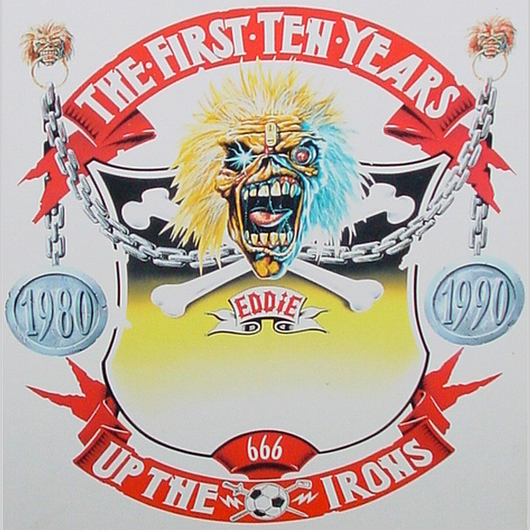
The First Ten Years
A series of 10 CDs and 12” singles celebrating Maiden’s first 10 years.
This was the boxset artwork - you’ll have probably noticed this stamp on some of the other images in this gallery. ‘Up The Irons’ is, of course, another reference to West Ham United FC.
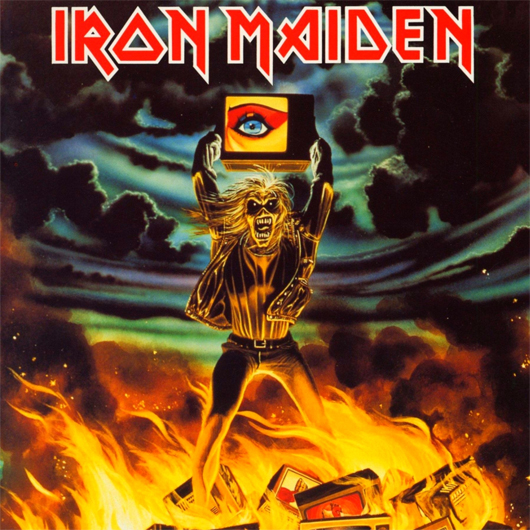
Holy Smoke
Holy Smoke was the first single from eighth studio album No Prayer For The Dying.
This was the first string of covers to ignore the continuity of previous artwork - Eddie’s lost his lobotomy scar!
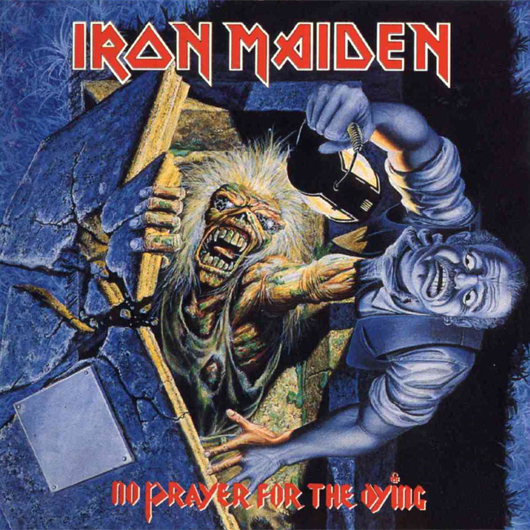
No Prayer For The Dying
Trivia time again!
Unlike the original cover above, the 1998 reissue features an inscription on the tomb’s plaque: “After the Daylight, The Night of Pain, That is not Dead, Which Can Rise Again.”
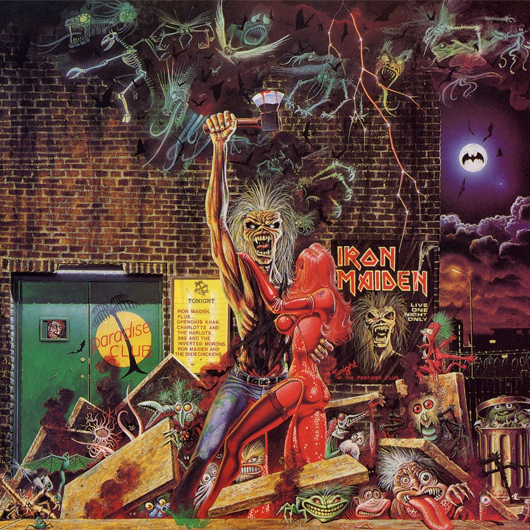
Bring Your Daughter… To The Slaughter
Originally intended by Riggs as a live album cover, this backdoor nightclub scene features a 3D version of Who Framed Roger Rabbit?’s Jessica Rabbit embracing Eddie and Sesame Street’s the Grouch in the bin on the far right. Charming.
Note that 'Charlotte And The Harlots' are listed as a support band on the poster behind Eddie.
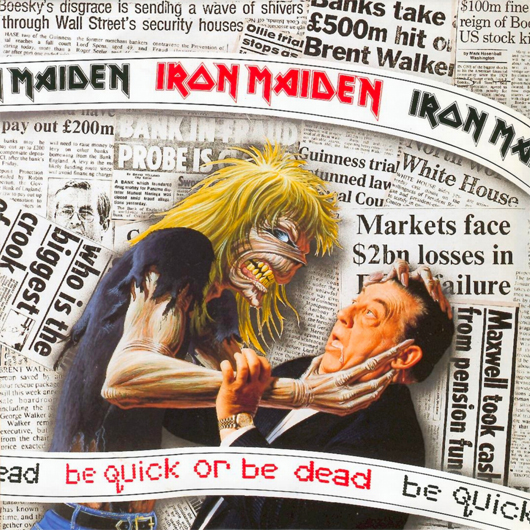
Be Quick Or Be Dead
By now Maiden were embracing - and Eddie was wading in on - the political scandals of the day.
In this case, our hero takes on Robert Maxwell, the European Stock Market crash and the BCCI (Bank of Credit and Commerce International) case.
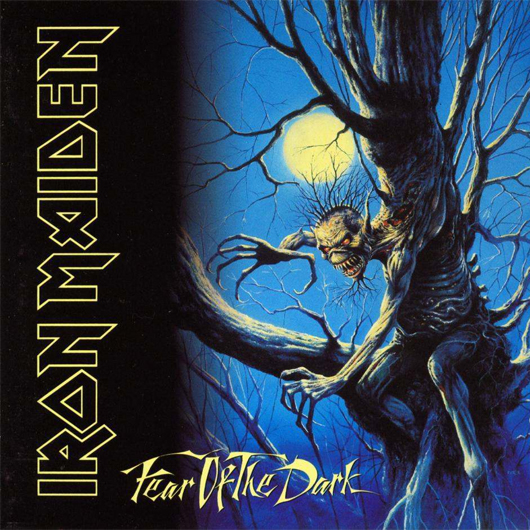
Fear Of The Dark
Nine albums in and Fear Of The Dark features the first LP artwork NOT designed by Derek Riggs. Instead, after creating ‘the best of three submissions’ the band chose Melvyn Grant’s terrifying tree apparition.
The next two singles - From Here To Eternity and Wasting Love (Maiden’s one and only power ballad released in The Netherlands) - were the first since 1984’s live version of Running Free not to feature Eddie on the cover. They used photos instead.
Completists corner: Photo sleeves can be found here (From Here To Eternity) and here (Wasting Love).
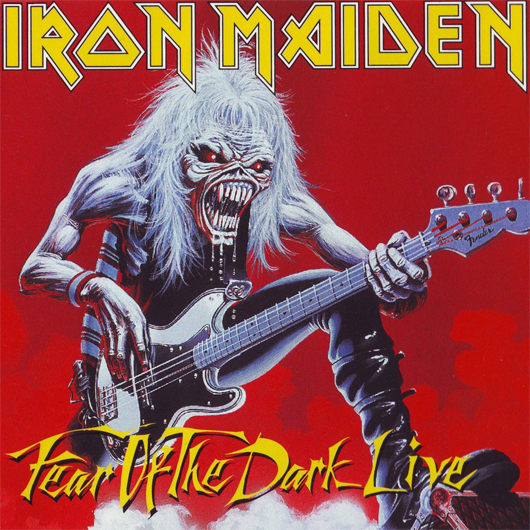
Fear Of The Dark (Live)
According to Riggs, this one was painted at “the request of [bassist] Steve Harris who wanted to associate himself with being Eddie…
"He actually wanted people to think that he was Eddie really, or that Eddie was based on him in some way.”
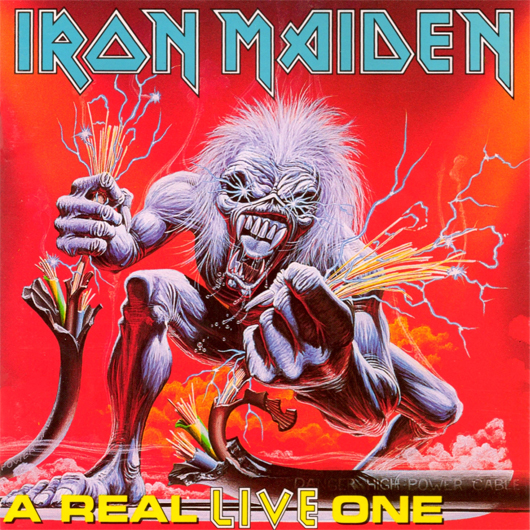
A Real Live One
A naked Eddie playing with live wires - fitting…
This was the first of three live albums released in 1993, recorded at nine venues in Europe during the Fear Of The Dark tour.
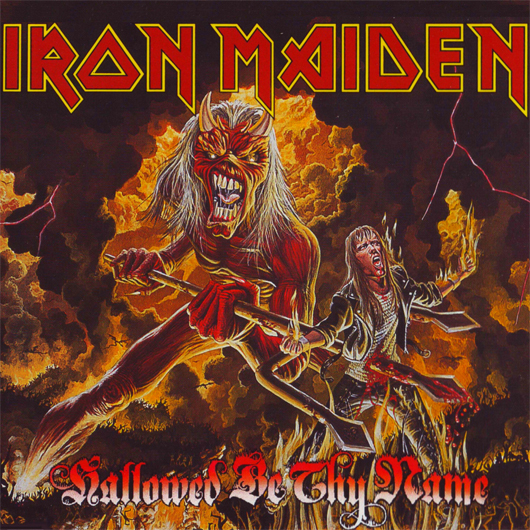
Hallowed Be Thy Name (Live)
Like Riggs’ scrapped Maiden Japan artwork featuring a soon-to-be-departing band member’s severed head (Paul Di’Anno’s), here Eddie takes the form of Satan to impale departing vocalist Bruce Dickinson with a pitchfork.
In this case, the cover wasn’t scrapped…
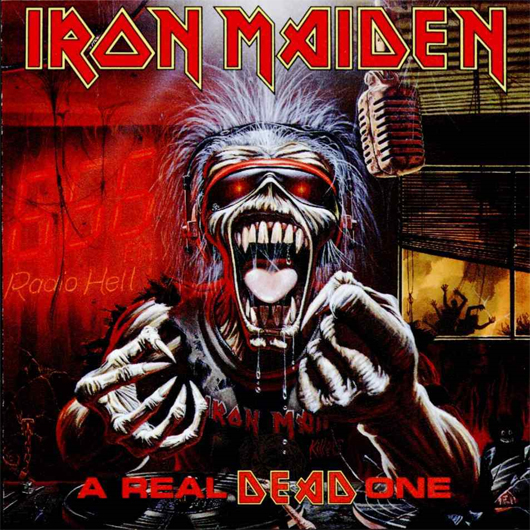
A Real Dead One
The second 1993 live LP release, again recorded across Europe during the previous two years. Here Eddie becomes a disk jockey… in hell.
Note: A combined version of the previous two albums called A Real Live Dead One was released in September 1993. It featured the same artwork as A Real Live One.
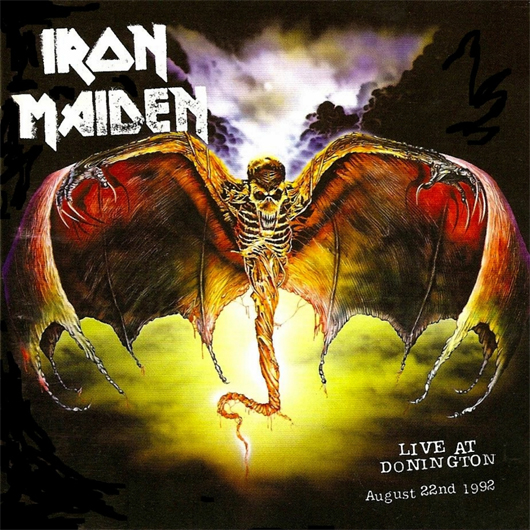
Live At Donington
The final release from the live saga featured two different covers.
One was white with simple black text reading: Iron Maiden Live At Donnington August 22nd 1982. the second cover (above) was originally a concert poster designed by Mark Wilkinson.
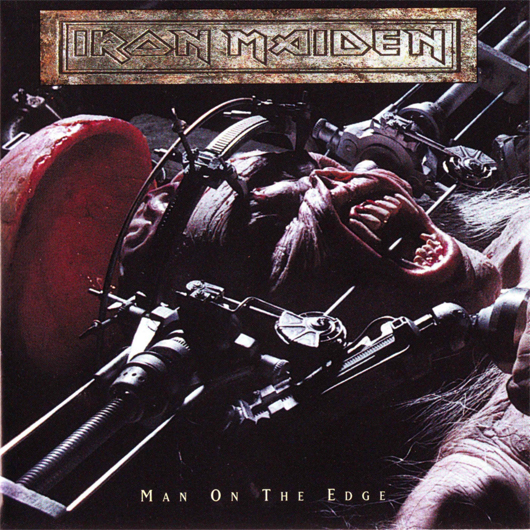
Man On The Edge
In a return to the lobotomy first featured on the cover of Piece Of Mind, by this point Maiden were attempting to bring Eddie’s animated form into ‘real life’.
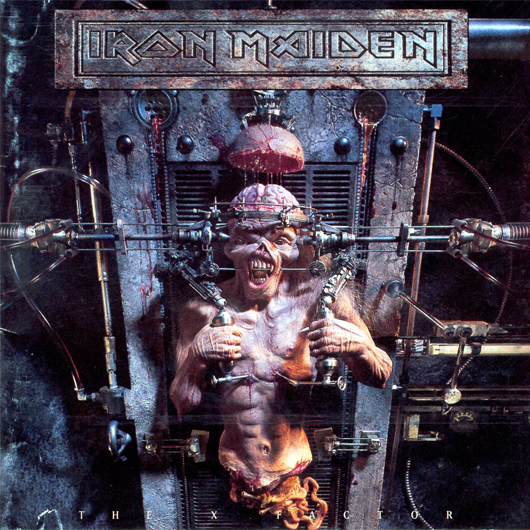
The X Factor
This very graphic cover was created by Hugh Syme.
Slightly less graphic versions featured Eddie from a distance, although the gruesome close-up was still included on the back of the artwork.
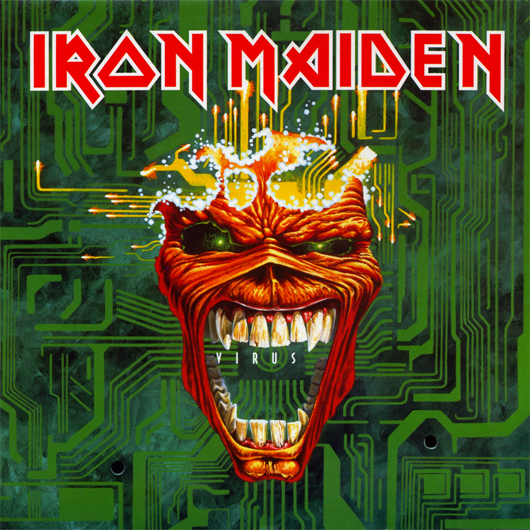
Virus
Back to Derek Riggs, and back to just Eddie The Head.
Virus was the first single since 1980’s Women In Uniform not to feature on a studio album.
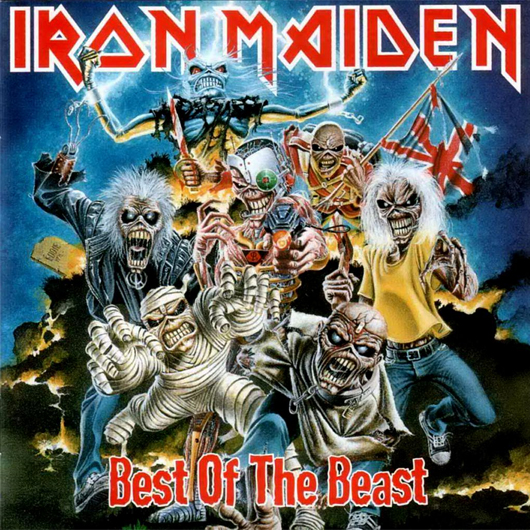
Best Of The Beast
It wouldn’t be a Maiden ‘Best Of’ (this was their first) without paying homage to the many guises of Eddie.
Best Of The Beast features Eddie from the Piece of Mind, Powerslave, Somewhere In Time and No Prayer For The Dying eras to The Trooper, Live After Death and Killers covers.
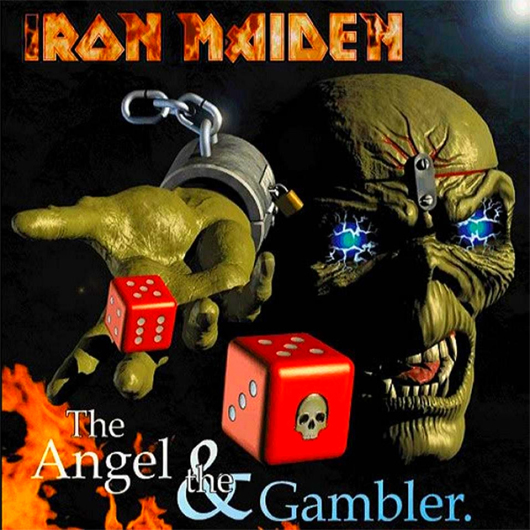
The Angel And The Gambler
Like the accompanying video, The Angel And The Gambler’s sleeve is computer-generated.
An alternative cover (on CD2) portrays Eddie welcoming you to a floating casino on a cruiser called Voodoo Queen.
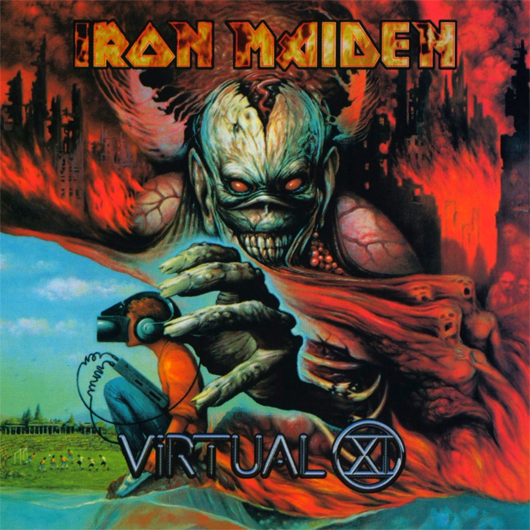
Virtual XI
Maiden’s eleventh studio LP (pronounced Virtual Eleven) ties in two of the band’s extra-curricular activities of the time.
The Ed Hunter videogame was on the verge of release and football was important as ever (check the bottom left). Melvyn Grant returned for artwork duties.
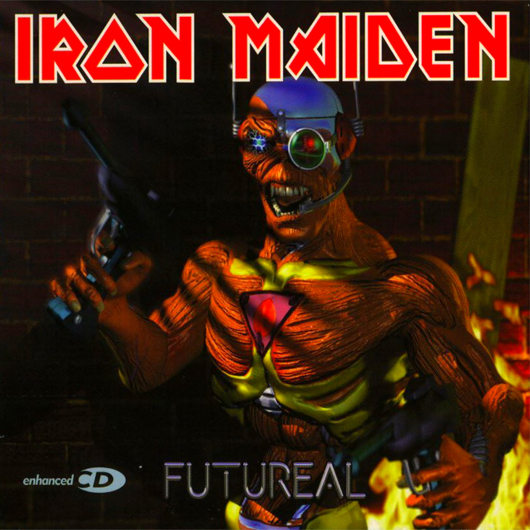
Futureal
Eddie returns to his Terminator-esque form as seen on the Somewhere In Time cover.
This time, Eddie comes in gorgeous-ish CG…
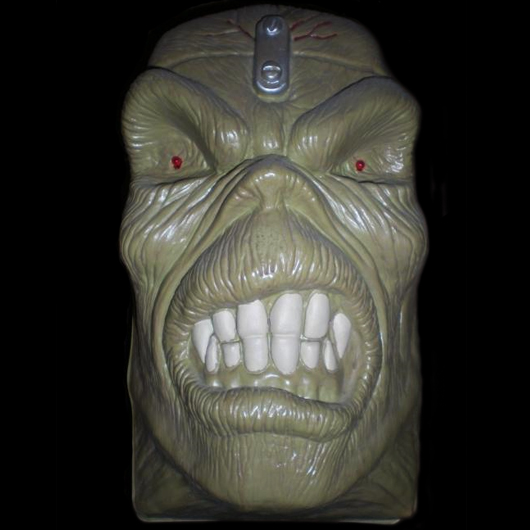
Eddie's Head
A head-shaped boxset containing the band’s first 12 albums (from Iron Maiden to Live At Donnington). When lined up together the spine of each CD forms the original Iron Maiden artwork.
Check out Iron Maiden France for more pics.
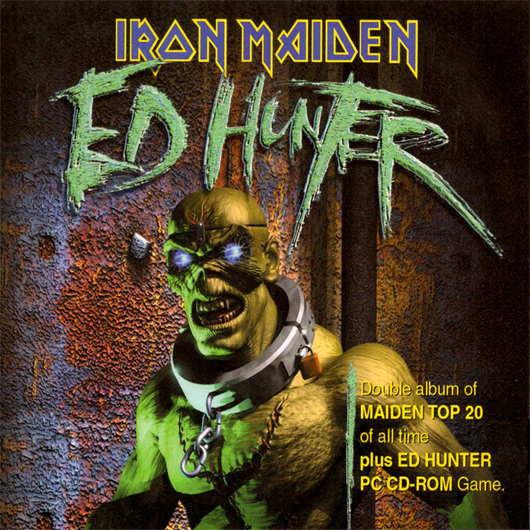
Ed Hunter
Accompanying the aforementioned Ed Hunter videogame was a compilation album - this was Maiden’s second ‘best of’ album but featured 20 fan-chosen tracks.
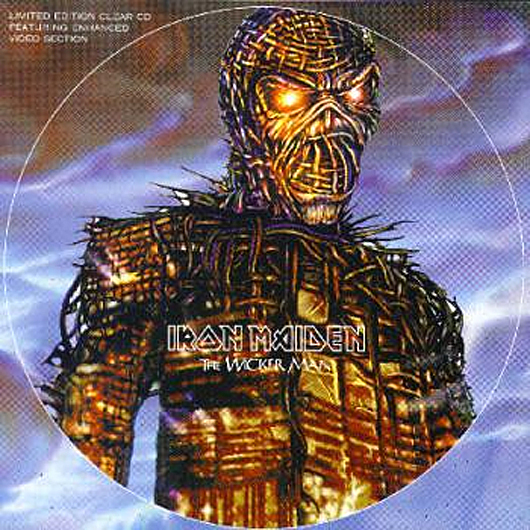
The Wicker Man
This was the alternative cover (the first was a photo of the band - possibly to mark the return of Bruce Dickinson) designed by Mark Wilkinson.
Riggs, whose effort was rejected, was now nearing the end of his Maiden tether...
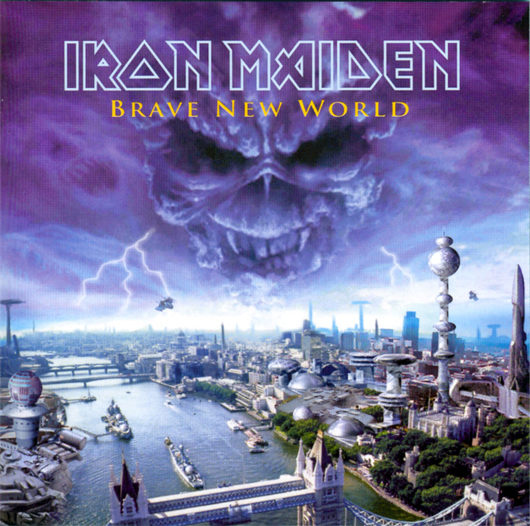
Brave New World
Just as Bruce Dickinson returned as frontman, Derek Riggs was departing as artman.
The top half was Riggs’ last new work for Maiden (the “they were getting increasingly difficult to work with” complaint from the Can I Play With Madness single 12 years earlier had evidently become impossible), while Steve Stone designed the bottom half.
The cover and album title are based on Aldous Huxley’s novel of the same name about ‘reproductive technology’ and ‘sleep-learning’.
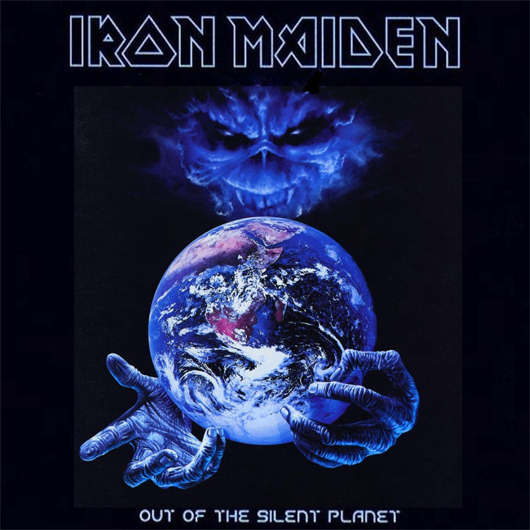
Out Of The Silent Planet
Another Mark Wilkinson effort, probably inspired by the song’s own influences: science fiction flick Forbidden Planet and CS Lewis’s 1938 novel of the same name.
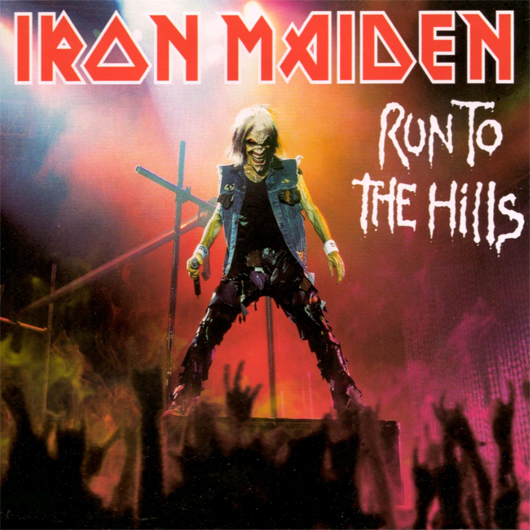
Run To The Hills (Live)
A third Run To The Hills release, but for a good cause: to raise money for former drummer Clive Burr’s MS Trust Fund.
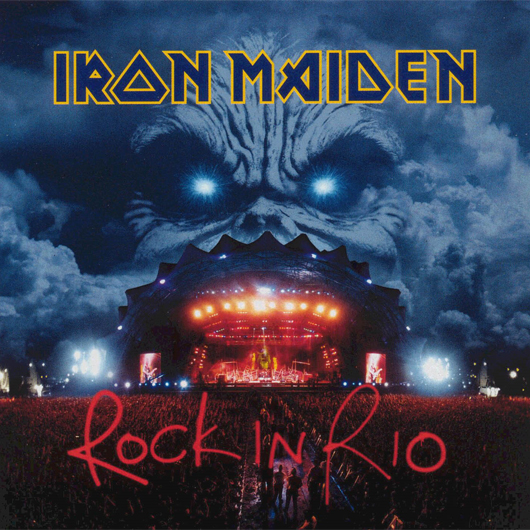
Rock In Rio
Recorded in front of Maiden’s second largest crowd of 250,000 people (ironically the biggest was 400,000 in Rio back in 1985).
Eddie watches on…
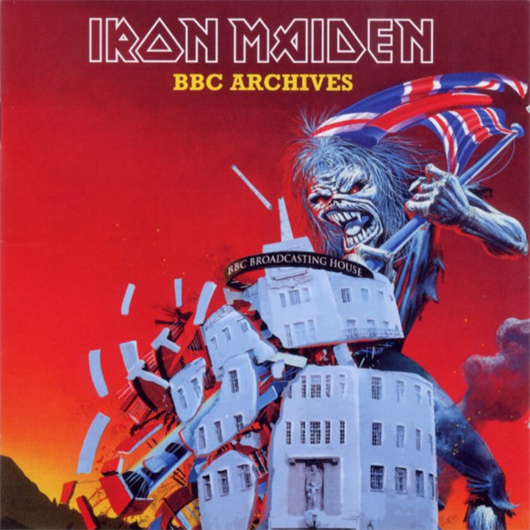
The BBC Archives
The first in a week-long slew of Maiden compilations to mark the release of Eddie’s Archive, which we’ll come to in a moment.
Riggs originally created this artwork for Billboard magazine to celebrate the band signing to Capitol Records. They changed the building and sign to fit with BBC Broadcasting House.
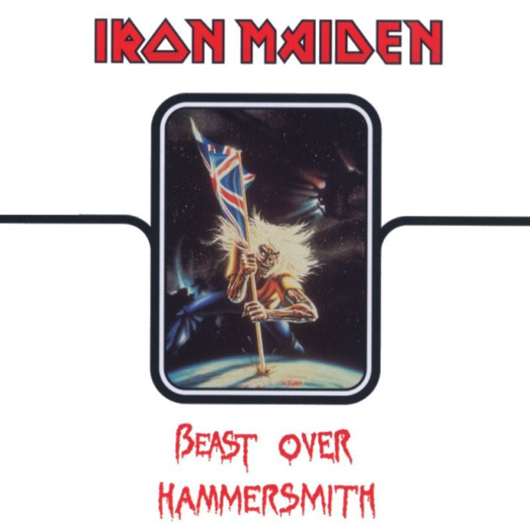
Beast Over Hammersmith
This live LP was recorded during The Beast On The Road tour at Hammersmith Odeon, London, 20 years earlier.
Fittingly, the band chose an older Eddie for the artwork. Riggs designed a poster for Iron Maiden’s Download Festival appearance with the same theme.
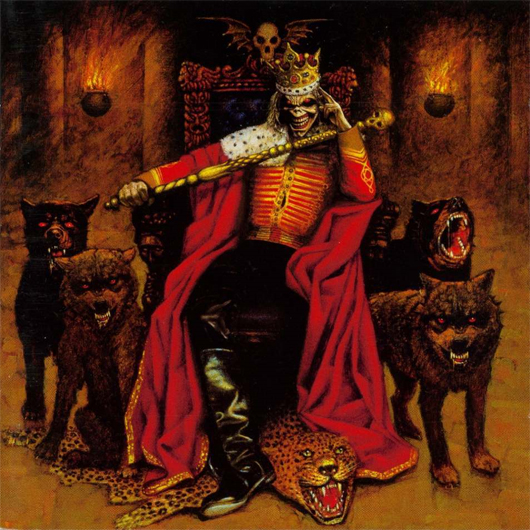
Edward The Great
All hail King Edward!
Maiden’s third ‘Best Of’ released on the same day - and in conjunction with - Eddie’s Archive box set (next up) as an accessible introduction for new fans.
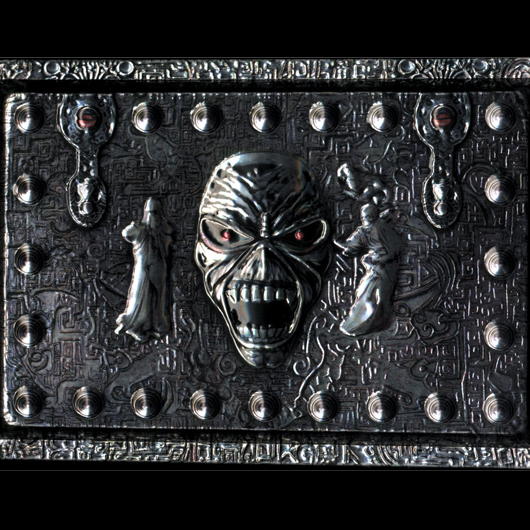
Eddie's Archive
An embossed metal casket-like box containing three double CDs: The BBC Archives, Beast Over Hammersmith and a new Best Of The ‘B’ Sides; the Iron Maiden family tree (updated from the version which originally appeared in 1993’s A Real Dead One); and a shot glass. Check out Metal.org for a close-up.
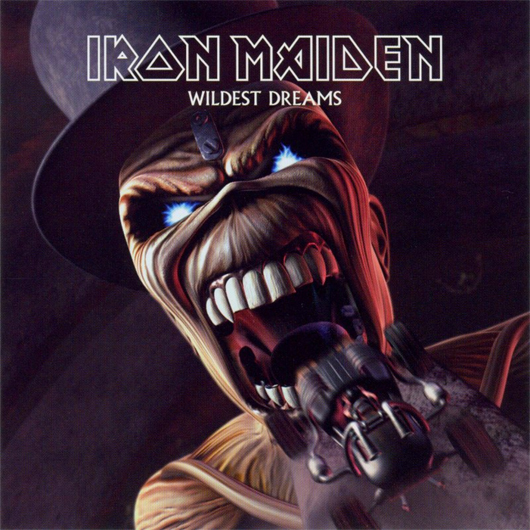
Wildest Dreams
Based on the accompanying computer-animated music video in which the band drive into Eddie’s mouth. Lovely.
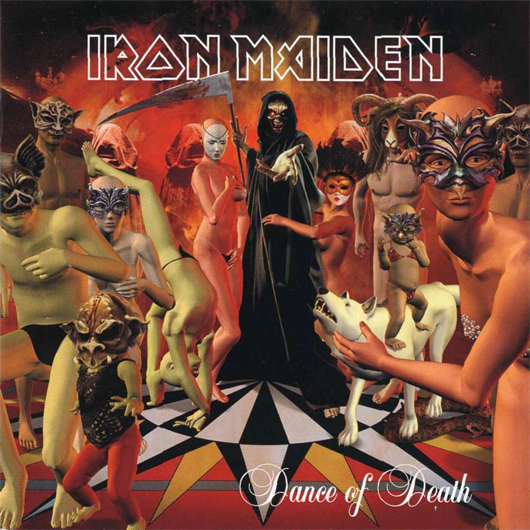
Dance Of Death
Apparently, Maiden’s 13th studio LP artwork designer, David Patchett, wanted to dissociate himself from the finished product because the band decided to use his ‘unfinished prototype’.
One look at Maiden World’s list of Dance Of Death cover mistakes will explain why - broken neck, dislocated shoulder, baby’s foot cutting into dog’s back, dog standing on snake…
Awful.
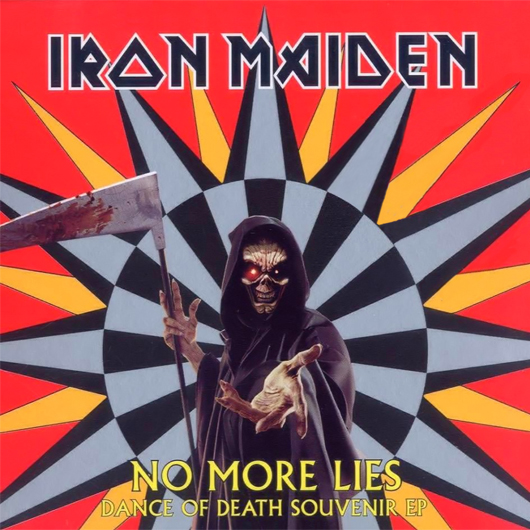
No More Lies
In-keeping with the ‘Eddie as Grim Reaper’ theme, the No More Lies boxed EP was released as a ‘thank you’ to fans and came with an Iron Maiden sweatband.
On 5 July 2005 came a North American-only release called The Essential Iron Maiden (part of Sony’s ‘Essential’ series) followed by another live Number Of The Beast single. The album’s cover is a photo of the band posing on flight cases.
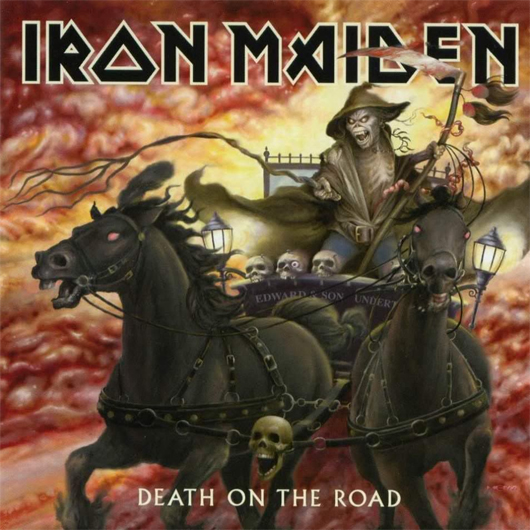
Death On The Road
A live CD, LP and DVD recorded at Westfalenhalle, Dortmund, Germany during the Dance Of Death Tour in 2003.
Eddie turns Funeral Director Of The Apocalypse in this Melvyn Grant-designed artwork. The words ‘Edward & Son Undertakers’ are inscribed on his carriage.
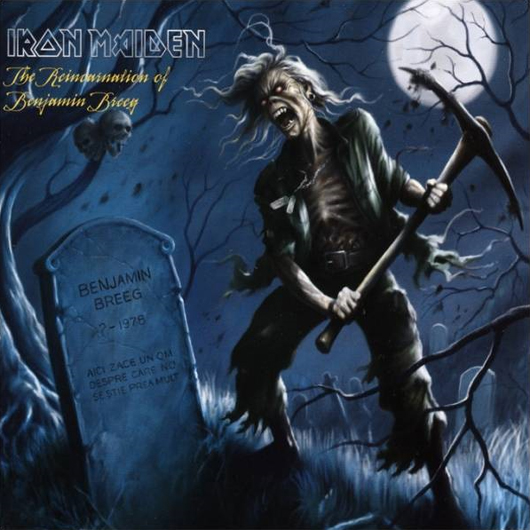
The Reincarnation of Benjamin Breeg
While a quick Google of ‘Benjamin Breeg’ throws up any number of forum debates and conspiracy theories, no one’s really sure who the title character is, or was.
At a guess, we’re inclined to believe this ‘extremely disturbed individual’ explanation. Or it may well have been Eddie’s name in a former life. Either way, Ed’s intent on digging him up in this Melvyn Grant-designed artwork.
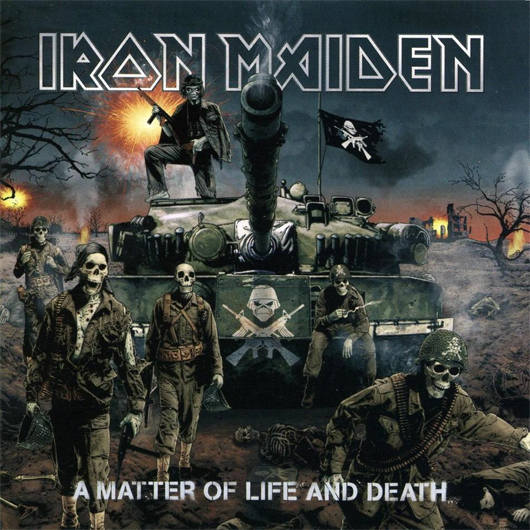
A Matter Of Life And Death
Recurring themes of war and religion provide the basis of Maiden’s fourteenth studio album, A Matter Of Life And Death.
Eddie takes the form of an entire zombie-like squadron for the artwork designed by Tim Bradstreet.
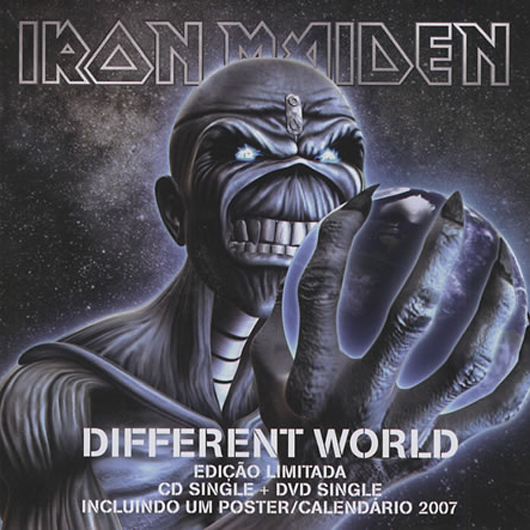
Different World
The second and final single from ‘Life And Death is a tribute to Thin Lizzy - in particular Phil Lynott’s vocals.
Eddie looks like he’s about to take a bite out of the world.
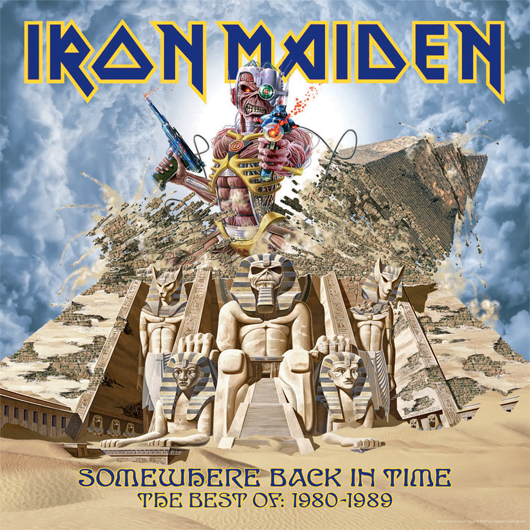
Somewhere Back In Time
Another world tour, another accompanying best of.
Fittingly for a jaunt called Somewhere Back In Time, the album covers the first nine years of Maiden releases (1980-1989) while the artwork revisits Pharaoh Eddie and Cyborg Eddie from the Powerslave and Somewhere In Time albums respectively.
The Flight 666 concert documentary film followed a year later on 22 May. The poster and DVD artwork featured the band stood beneath the Iron Maiden plane, famously piloted by Bruce Dickinson himself.
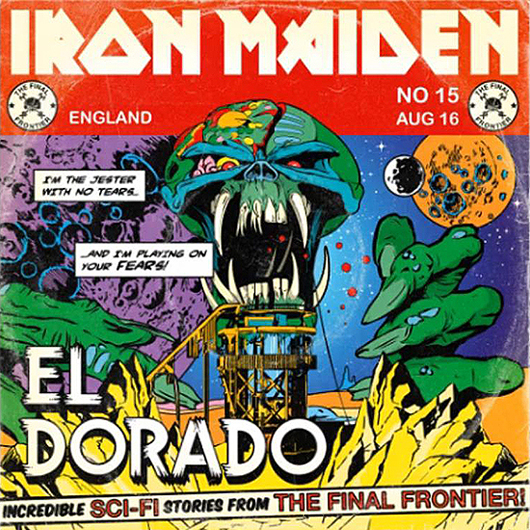
El Dorado
El Dorado was released as a free download on the eve of The Final Frontier World Tour.
The artwork by illustrator Anthony Dry is inspired by EC Comics - check out Metal Hammer’s delighted unboxing of the comic book-like seven-inch promo single.

The Final Frontier
Melvyn Grant returned to the drawing board for Maiden's 15th studio LP, The Final Frontier. Befittingly of its title, an alien-like Eddie has conquered space (you know, the final frontier) - one skeletal astronaut’s helmet at a time.
Some are speculating that this is to be Maiden’s last album, a rumour that - while it makes the title all the more meaningful - if true, would mark the end of a 30-year heavy metal tenure and a genre-defining run of graphic artwork.
Fans can at least take some solace by watching Ed’s all-new alien incarnation brought to life for The Final Frontier Tour, and in the title track’s accompanying video. You can also check our the amazing new Final Frontier 3D cover on the latest issue of Metal Hammer. Guess who gets the last laugh?
Up the Irons!
Liked this? Now read: Iron Maiden: The Final Frontier review track-by-track
Connect with MusicRadar: via Twitter, Facebook and YouTube
Get MusicRadar straight to your inbox: Sign up for the free weekly newsletter
Tom Porter worked on MusicRadar from its mid-2007 launch date to 2011, covering a range of music and music making topics, across features, gear news, reviews, interviews and more. A regular NAMM-goer back in the day, Tom now resides permanently in Los Angeles, where he's doing rather well at the Internet Movie Database (IMDB).
